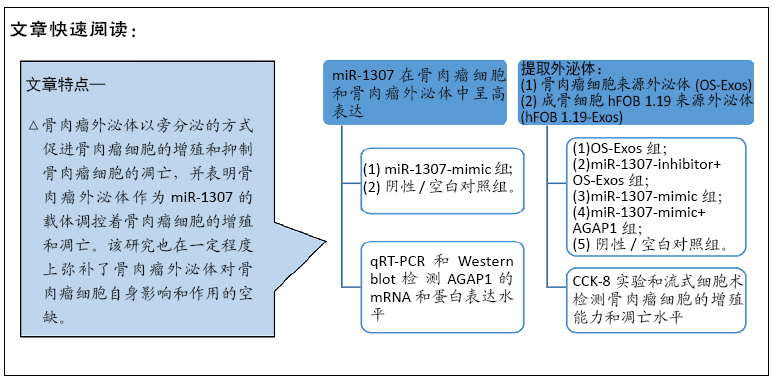[1] BROWN HK, TELLEZ-GABRIEL M, HEYMANN D. Cancer stem cells in osteosarcoma. Cancer Lett. 2017;386:189-195.
[2] MORENO F, CACCIAVILLANO W, CIPOLLA M, et al. Childhood osteosarcoma: Incidence and survival in Argentina. Report from the National Pediatric Cancer Registry, ROHA Network 2000-2013. Pediatr Blood Cancer. 2017; 64(10):e26533.
[3] BRICCOLI A, ROCCA M, SALONE M, et al. High grade osteosarcoma of the extremities metastatic to the lung: long-term results in 323 patients treated combining surgery and chemotherapy, 1985-2005. Surg Oncol. 2010;19(4): 193-199.
[4] MORTUS JR, ZHANG Y, HUGHES DP. Developmental pathways hijacked by osteosarcoma. Adv Exp Med Biol. 2014;804:93-118.
[5] POWERS M, ZHANG W, LOPEZ-TERRADA D, et al. The molecular pathology of sarcomas. Cancer Biomark. 2010;9(1-6):475-491.
[6] SHAO XJ, MIAO MH, XUE J, et al. The Down-Regulation of MicroRNA-497 Contributes to Cell Growth and Cisplatin Resistance Through PI3K/Akt Pathway in Osteosarcoma. Cell Physiol Biochem. 2015;36(5):2051-2062.
[7] SHEN K, MAO R, MA L, et al. Post-transcriptional regulation of the tumor suppressor miR-139-5p and a network of miR-139-5p-mediated mRNA interactions in colorectal cancer. FEBS J. 2014;281(16):3609-3624.
[8] XUE J, NIU J, WU J, et al. MicroRNAs in cancer therapeutic response: Friend and foe. World J Clin Oncol. 2014;5(4):730-743.
[9] MA C, ZHAN C, YUAN H, et al. MicroRNA-603 functions as an oncogene by suppressing BRCC2 protein translation in osteosarcoma. Oncol Rep. 2016;35(6): 3257-3264.
[10] LI BL, LU C, LU W, et al. miR-130b is an EMT-related microRNA that targets DICER1 for aggression in endometrial cancer. Med Oncol. 2013;30(1):484.
[11] QIU X, DOU Y. miR-1307 promotes the proliferation of prostate cancer by targeting FOXO3A. Biomed Pharmacother. 2017;88:430-435.
[12] HAN S, ZOU H, LEE JW, et al. miR-1307-3p Stimulates Breast Cancer Development and Progression by Targeting SMYD4. J Cancer. 2019;10(2): 441-448.
[13] SHIMOMURA A, SHIINO S, KAWAUCHI J, et al. Novel combination of serum microRNA for detecting breast cancer in the early stage. Cancer Sci. 2016;107(3): 326-334.
[14] CHEN WT, YANG YJ, ZHANG ZD, et al. MiR-1307 promotes ovarian cancer cell chemoresistance by targeting the ING5 expression. J Ovarian Res. 2017;10(1):1.
[15] CHEN S, WANG L, YAO B, et al. miR-1307-3p promotes tumor growth and metastasis of hepatocellular carcinoma by repressing DAB2 interacting protein. Biomed Pharmacother. 2019;117:109055.
[16] MINCIACCHI VR, FREEMAN MR, DI VIZIO D. Extracellular vesicles in cancer: exosomes, microvesicles and the emerging role of large oncosomes. Semin Cell Dev Biol. 2015;40:41-51.
[17] OHNO S, TAKANASHI M, SUDO K, et al. Systemically injected exosomes targeted to EGFR deliver antitumor microRNA to breast cancer cells. Mol Ther. 2013;21(1): 185-191.
[18] ALVAREZ-ERVITI L, SEOW Y, YIN H, et al. Delivery of siRNA to the mouse brain by systemic injection of targeted exosomes. Nat Biotechnol. 2011;29(4): 341-345.
[19] BRAICU C, TOMULEASA C, MONROIG P, et al. Exosomes as divine messengers: are they the Hermes of modern molecular oncology? Cell Death Differ. 2015; 22(1):34-45.
[20] RAIMONDI L, DE LUCA A, GALLO A, et al. Osteosarcoma cell-derived exosomes affect tumor microenvironment by specific packaging of microRNAs. Carcinogenesis. 2019:bgz130.
[21] WANG JW, WU XF, GU XJ, et al. Exosomal miR-1228 From Cancer-Associated Fibroblasts Promotes Cell Migration and Invasion of Osteosarcoma by Directly Targeting SCAI. Oncol Res. 2019;27(9):979-986.
[22] GONG L, BAO Q, HU C, et al. Exosomal miR-675 from metastatic osteosarcoma promotes cell migration and invasion by targeting CALN1. Biochem Biophys Res Commun. 2018;500(2):170-176.
[23] SHIMBO K, MIYAKI S, ISHITOBI H, et al. Exosome-formed synthetic microRNA-143 is transferred to osteosarcoma cells and inhibits their migration. Biochem Biophys Res Commun. 2014;445(2):381-387.
[24] OTTAVIANI G, JAFFE N. The epidemiology of osteosarcoma. Cancer Treat Res. 2009;152:3-13.
[25] TANG N, SONG WX, LUO J, et al. Osteosarcoma development and stem cell differentiation. Clin Orthop Relat Res. 2008;466(9):2114-2130.
[26] WANG B, QU XL, LIU J, et al. HOTAIR promotes osteosarcoma development by sponging miR-217 and targeting ZEB1. J Cell Physiol. 2019;234(5):6173-6181.
[27] ZHANG S, WANG Y, CHEN S, et al. Silencing of cytoskeleton-associated protein 2 represses cell proliferation and induces cell cycle arrest and cell apoptosis in osteosarcoma cells. Biomed Pharmacother. 2018;106:1396-1403.
[28] SANG W, ZHU L, MA J, et al. Lentivirus-Mediated Knockdown of CTHRC1 Inhibits Osteosarcoma Cell Proliferation and Migration. Cancer Biother Radiopharm. 2016;31(3):91-98.
[29] 崔国宁,刘喜平,虎峻瑞,等.不同来源外泌体与肿瘤发病相关性的研究与进展[J].中国组织工程研究,2020,24(13):2095-2101.
[30] LIN F, YIN HB, LI XY, et al. Bladder cancer cell‑secreted exosomal miR‑21 activates the PI3K/AKT pathway in macrophages to promote cancer progression. Int J Oncol. 2020;56(1):151-164.
[31] DUAN B, SHI S, YUE H, et al. Exosomal miR-17-5p promotes angiogenesis in nasopharyngeal carcinoma via targeting BAMBI. J Cancer. 2019;10(26):6681-6692.
[32] HE L, ZHU W, CHEN Q, et al. Ovarian cancer cell-secreted exosomal miR-205 promotes metastasis by inducing angiogenesis. Theranostics. 2019;9(26):8206-8220.
[33] SHANG D, XIE C, HU J, et al. Pancreatic cancer cell-derived exosomal microRNA-27a promotes angiogenesis of human microvascular endothelial cells in pancreatic cancer via BTG2. J Cell Mol Med. 2020;24(1):588-604.
[34] CHE X, JIAN F, CHEN C, et al. PCOS serum-derived exosomal miR-27a-5p stimulates endometrial cancer cells migration and invasion. J Mol Endocrinol. 2020;64(1):1-12.
[35] NIE Z, STANLEY KT, STAUFFER S, et al. AGAP1, an endosome-associated, phosphoinositide-dependent ADP-ribosylation factor GTPase-activating protein that affects actin cytoskeleton. J Biol Chem. 2002;277(50):48965-48975.
[36] MEURER S, PIOCH S, WAGNER K, et al. AGAP1, a novel binding partner of nitric oxide-sensitive guanylyl cyclase. J Biol Chem. 2004;279(47):49346-49354.
[37] BENDOR J, LIZARDI-ORTIZ JE, WESTPHALEN RI, et al. AGAP1/AP-3-dependent endocytic recycling of M5 muscarinic receptors promotes dopamine release. EMBO J. 2010;29(16):2813-2826.
[38] TSUTSUMI K, NAKAMURA Y, KITAGAWA Y, et al. AGAP1 regulates subcellular localization of FilGAP and control cancer cell invasion. Biochem Biophys Res Commun. 2020;522(3):676-683.
|
 文题释义:
文题释义:





